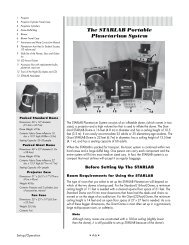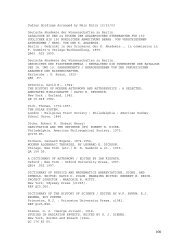K-6 Activities - Dudley Observatory
K-6 Activities - Dudley Observatory
K-6 Activities - Dudley Observatory
You also want an ePaper? Increase the reach of your titles
YUMPU automatically turns print PDFs into web optimized ePapers that Google loves.
Materials<br />
• STARLAB Portable Planetarium<br />
• arrow pointers<br />
• Starfield Cylinder<br />
• red flashlights (for reading)<br />
Objectives<br />
K–6 <strong>Activities</strong> • B–30 •<br />
Stars and Constellations<br />
Students will be able to:<br />
1. Determine star colors.<br />
2. Match hot and cool stars with proper color.<br />
3. Explain that the sun is the closest star; other stars are very far away.<br />
4. Determine the magnitude of various stars in the winter sky.<br />
5. Identify Rigel, Betelgeuse, Sirius, Procyon, Aldebaran, Pollux and Castor as<br />
bright stars and identify the constellations in which those stars are located in the<br />
winter sky.<br />
6. Find the winter and summer triangle.<br />
Process Skills<br />
Describing • observing • interpreting • communicating • inferring • working cooperatively<br />
Background information<br />
Share the following information with students.<br />
1. Stars vary in color.<br />
a. The color of a star is determined by its temperature.<br />
b. Red stars are the coolest stars.<br />
c. Blue-white stars are the hottest stars.<br />
2. Stars vary greatly in size.<br />
a. Our sun is a medium-sized star.<br />
b. The red giants are the largest stars.<br />
c. The white dwarfs are the smallest stars.<br />
Procedure<br />
Point out red stars (Betelgeuse in Orion, Antares in Scorpius) and blue-white stars (Rigel<br />
in Orion and Spica in Virgo). With a dimmer switch and a clear glass bulb, show<br />
how the cooler filament is red, just before the bulb goes out, and the hottest filament<br />
turned all the way up is white or bluish. Have students compare the hottest part of a<br />
bonfire (blue flame), the coolest part, (red flame), or the most efficient color on a gas<br />
stove (blue).<br />
3. The magnitude of a star refers to its observed brightness.<br />
a. The lower the magnitude, the brighter the star.<br />
b. Stars fainter than the sixth magnitude cannot be seen with unaided eyes.<br />
4. Stars vary greatly in distance from the earth.<br />
a. The sun is our closest star.<br />
b. The stars are so far away that we cannot easily measure the distance in<br />
miles.<br />
c. If you travel 1000 miles an hour, it would take you 3 million years to reach<br />
the nearest star excluding the sun.





